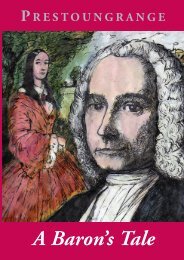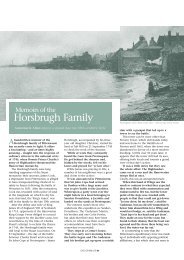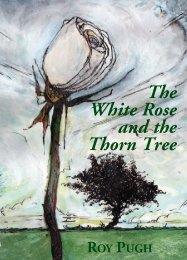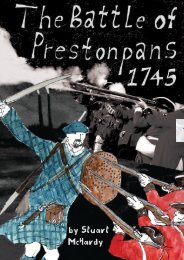Battle of Prestonpans 1745
Battle of Prestonpans 1745
Battle of Prestonpans 1745
Create successful ePaper yourself
Turn your PDF publications into a flip-book with our unique Google optimized e-Paper software.
VICTORY AT PRESTONPANS<br />
little isle <strong>of</strong> Eriskay in the Outer Hebrides on 23 July, and then<br />
in the afternoon <strong>of</strong> the 25th at Arisaig on one <strong>of</strong> the most<br />
secluded coasts <strong>of</strong> the western Scottish mainland.<br />
The Prince was putting his sympathisers to a very severe test<br />
when he came ashore with a tiny group <strong>of</strong> ill-assorted<br />
associates, the ‘Seven Men <strong>of</strong> Moidart’. Some clan chiefs were<br />
hostile while others were uneasy about the lack <strong>of</strong> French<br />
assistance, but the Prince had working for him the ancient<br />
Scottish loyalties to the House <strong>of</strong> Stuart and the resentment<br />
which many Scots felt against the political Union with<br />
England in 1707. Deploying all his persuasive charm Charles<br />
made a valuable conquest in the form <strong>of</strong> Donald Cameron <strong>of</strong><br />
Lochiel, who commanded much respect among the western<br />
clans. He also won over the old and bent John Gordon <strong>of</strong><br />
Glenbucket, who was the first <strong>of</strong> the eastern lairds to declare<br />
himself. On 19 August the first sizeable force assembled at<br />
Glenfinann at the head <strong>of</strong> Loch Shiel, and the Jacobites raised<br />
their standard <strong>of</strong> red and white.<br />
On the next day the Prince’s men began their eastward<br />
march while the Hanoverian government’s commander in<br />
Scotland, Lieutenant General Sir John Cope, set out from<br />
Stirling for the Highlands with a scratch force <strong>of</strong> about 1,500<br />
troops. A battle seemed to be in the making for the rivals were<br />
converging from opposite sides on the great grey ridge <strong>of</strong> the<br />
Monadhliath Mountains which separated the Great Glen from<br />
Upper Strathspey. At this juncture, however, Cope lost his<br />
nerve. On 27 August he abandoned his attempt to gain the<br />
high Corrieyairack Pass and over the following two days he<br />
fled north-east to Inverness, convinced that the Jacobites were<br />
at his heels.<br />
On 28 August, a day <strong>of</strong> blazing heat, Prince Charles and his<br />
men crossed the Corrieyairack unopposed and descended into<br />
Strathspey. Charles was playing for high stakes. He rightly<br />
rejected the opportunity to chase and beat Cope who by<br />
removing himself from the scene had opened the way to the<br />
Lowlands. On 29 August the Jacobites arrived at Dalwhinnie<br />
at the head <strong>of</strong> the new military road which led so conveniently<br />
to the south. They were at Blair Castle on Atholl on 1<br />
September. Two days later they traversed the narrows <strong>of</strong><br />
Killiecrankie and on the 4th reached Perth, where they rested<br />
and gathered strength until the 11th. They came to Dunkeld<br />
on the 12th September and the next day they reached the<br />
Lowlands where they passed the upper Forth at the Fords <strong>of</strong><br />
Frew, a step <strong>of</strong> great symbolic and practical importance.<br />
4










